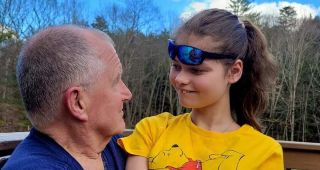Cognition
Nonverbal Children: An Interview With Ed Fennell
A turning point for nonverbal children may be on the way.
Posted July 23, 2023 Reviewed by Jessica Schrader
Key points
- There is a gap in research on nonverbal children.
- There is a need for new measurement tools to test for attention and cognition.
- Brain-computer interfacing may provide some answers.

Ed Fennell represents the voice of a considerable number of advocates for nonverbal children (parents, educators, clinicians, and researchers) and he is doing something about it. His precise message is aimed at trying to fill a gap within research.
Ed began his career as a child care worker specializing in child abuse and developmental disabilities. A venture into a political career led to the founding of a firm specializing in governmental finance. Ed is retired and now cares for his daughter's special needs children.
Ed: I am working to redefine the way psychology and neurology look at children who are nonverbal and presumed profoundly intellectually disabled, Fennell says. [Recently] the Journal of the American Medical Association (JAMA) report showed that 2.2 million to 2.9 million children and adolescents may have a nonverbal learning disability.1 These children are at risk of being labeled as profoundly intellectually disabled. In other words, if they can't answer questions, they must not have anything to say. The reason is simple: science lacks the testing protocols to measure their preserved cognition. I am pushing to create those measurement tools.
To be transparent, I’ve known Ed Fennell for the better part of two decades and had a firsthand glimpse of the areas we are about to address and their evolution to what I believe is a pretty exciting development. The following are highlights of where Ed’s work has taken him from caregiving to spokesperson at an international conference on pediatric neurology. But his motivation started years back.
Ed: In 2007 my daughter gave birth to a beautiful baby girl but soon thereafter (4 weeks), she started having seizures. I was a daily witness to my granddaughter's struggle to develop normally. I was witness to the onset of a neurodegenerative disability. It is a journey one can only know by living through it. There is grief knowing your beautiful child will never walk or talk and there are no treatments or cures. However, early on I noticed that her eyes were always clear, bright, and attentive. I constructed mini experiments that convinced me her sight and hearing were intact. Her vocalizations were distinctive and conveyed needs. She had a receptive vocabulary; she conveyed meaning in a unique nonverbal manner. Her disability deprived her of expressing her thoughts and feelings. When Haley, my granddaughter, was 4, I began writing a blog, Chatting with Haley and Poppy, to draw attention to the issue of parental stress in raising nonverbal children. Advocacy groups representing these children noticed. In 2022, we found an article in an engineering journal that I felt would be the catalyst to propel new research.
I knew that Ed didn't just come up with a mission in 2022. So, we pursued that.
Ed: No ... we started this journey long ago. In 2011 when Haley was 4 years old, we began our blog, Chatting with Haley and Poppy. The blog which began when Haley was 4 slowly evolved from a focus on parental stress to a focus on the preserved cognition of silent children. It gained notoriety in the neurodevelopmental disorders field in the last four years. As a result of that notoriety, we were asked to present our thoughts at the International Foundation of CDKL5 Research Conference in 2019 in College Park, Maryland. That is where my initiative was endorsed by the foundation. That was a turning point.
According to Katheryn Elibri Frame, DO and president/founder CDKL5 Research Collaborative and Kiera’s Hope Project, “Mr. Fennell’s passion for helping his granddaughter, and in turn, untold numbers of individuals with complex neurological disorders, has led him to the young field of brain-computer interfacing.”
And that inspiration first came to Ed with the aforementioned 2022 article. I asked if he would give a little more context. Where does engineering come in?
Ed: The Poznan Supercomputing Networking Center had just completed phase one of designing prostheses for translating the non-verbal language of children who had profound intellectual and multiple disabilities. I contacted them and we entered a partnership. As far as we know this prototype and their application to PLMD nonverbal children is a first. It presumes these children have preserved cognition, which because of physical disabilities, they cannot demonstrate. The system is designed to do so. It is utilizing methods that track eye gaze, body movements, posture, gestures, vocalizations, non-intrusive physiological data, AI, and machine language to interpret nonverbal language.
Things don't happen overnight. In the fall of 2022, after discovering the article earlier in the year, he attended an international conference in Cambridge Massachusetts. There he met Dr. Teruyuki Tanaka (University of Tokyo). Tanaka recalled his 2019 speech at College Park. They spoke about the article disclosing the development of a prosthesis for nonverbal communication. Tanaka thought it important enough to arrange a presentation at the 2nd ASIA CDKL5 Conference, this fall of 2023. It will be held at the International Research Center for Neurointelligence, University of Tokyo, Institutes for Advanced Study. Sponsors include the CDKL5 Alliance, the Loulou Foundation, Boston Children’s Hospital, and Harvard.
Chiming in, Elibri Frame notes, “Ed has found a way to bring scientists, engineers, and clinicians together from around the world to focus on the most neglected and underestimated among us … those with severe cognitive and communication challenges. Ed is using his unique talents and skills to reach across disciplines and find ways for these BCI leaders to work together to improve people’s lives. What an exciting time this is!”
Knowing Ed Fennell, I already surmised his efforts would not end in Tokyo. So, I asked him, "What’s next?"
Ed: After the Tokyo conference, PSCN and I are planning a conference of scientists that will drive this technology forward. We have already approached a leading engineering school and its computer, bioengineering, and cognitive science departments along with its Research Development Office. When we are in Tokyo, we will also speak to the people representing the medical and Research staff of Harvard and Boston Children’s Hospital.
Ed’s mantra: "Nonverbal does not mean a child cannot hear, think, feel, or understand.”
References
Margolis, Amy, J. Broitman, J.M. Davis JAMA (2020). https://jamanetwork.com/journals/jamanetworkopen/fullarticle/2764298#:~:text=When%20applied%20to%20the%20US,be%203%25%20to%204%25.




